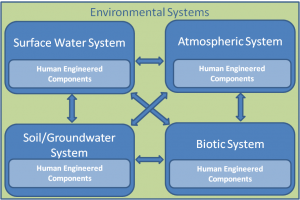Water Teaching Materials
Water: Research Professional Development Materials Assessment Materials
The School Water Pathways project is a weeklong inquiry-based module for middle and high school students organized using the 5E educational model. We begin by engaging the students with the following research question:
“How much water falls on our schoolyard during a year and where does it go?”
In order to answer this question, the students need to quantitatively evaluate the pathways water takes within the limited area of the school property. Determining the inputs is relatively straightforward. They simply use the annual precipitation for their town and the area of the school grounds to determine the volume of water input. Assessing the pathways is much more complicated and is broken down into 4 separate explorations:
- 1.1) determining the proportions of different surface types,
- 1.2) mapping runoff potential,
- 2) measuring evaporation,
- 3) measuring transpiration, and
- 4) measuring infiltration.
Each exploration involves teams of students taking measurements in different locations of the schoolyard and comparing results. The purpose of the hands-on explorations is to give students the opportunity to observe processes first hand in an outdoor setting and get a feel for the rates of water movement involved.
Once students understand the individual water processes and pathways, they are well positioned to explain the relative proportions of water traveling through the different pathways. This exercise is made easier by using a logic model that helps students calculate the relative amounts of water evaporating, infiltrating, transpiring, and running off given the proportions of different surface types present on their school grounds. At this point, students begin to see the significance of runoff and we can elaborate by using their logic model to test scenarios such as evaluating the impact of replacing a lawn with a parking lot or identifying sources of pollution that could contaminate runoff. The initial and final student tasks are to draw depictions of the water cycle that serve as an effective measure of gain.
School Water Pathways Documents:
- Teacher Guide Version 3.2
- Engagement Presentation
- Tracing Pathways Excel Workbook
- Transparency Set
- Pathways Tool
- Student Worksheets
- Water and the Environment Booklet
- Infiltrometer Construction Instructions
- Water Cycle Video
Development of these materials was supported by a grant from the National Science Foundation: Targeted Partnership: Culturally relevant ecology, learning progressions and environmental literacy (NSF-0832173). Any opinions, findings, and conclusions or recommendations expressed in this material are those of the author(s) and do not necessarily reflect the views of the National Science Foundation.
